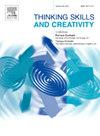资优与非资优五年级学生策略灵活性分析
IF 4.5
2区 教育学
Q1 Social Sciences
引用次数: 0
摘要
灵活性是创造力的重要组成部分,数学解题能力与创造力之间存在显著的相关关系。此外,非常规问题需要学生运用批判性思维、创造力和各种解决问题的技巧。因此,本研究的目的是考察资优和非资优五年级学生在非常规问题解决方面的问题解决成功和策略灵活性,并探讨这些因素之间的关系。为了达到这个目的,总共向40名五年级学生提出了8个非常规问题,其中20名是资优学生,20名是非资优学生。收集学生的书面解决方案,然后进行个别访谈。随后,对这些解决方案的成功程度和战略灵活性进行了评估。结果表明,资优学生比非资优学生更频繁地使用指标。此外,资优学生在中等类别和非资优学生在弱类别上有聚类的趋势。两组都包括了数量有限的灵活性高的学生。值得注意的是,灵活性和成功分数之间的显著关系仅在非天才学生中表现出来。天才学生和非天才学生在灵活性和成功方面的差异是显而易见的。讨论了这些发现对数学教育的影响,并对未来的研究提出了建议。本文章由计算机程序翻译,如有差异,请以英文原文为准。
An Analysis of Gifted and Non-Gifted Fifth Graders’ Strategic Flexibility
Flexibility constitutes a crucial element of creativity, and there exists a significant correlation between mathematical problem-solving abilities and creativity. Moreover, non-routine problems necessitate students to employ critical thinking, creativity, and various problem-solving techniques. Hence, the objective of this holistic multiple case study is to examine the problem solving success and strategic flexibility of both gifted and non-gifted fifth graders in non-routine problem solving, as well as exploring the relationship between these factors. To achieve this aim, a total of eight non-routine problems were presented to 40 fifth graders, with 20 being gifted and 20 non-gifted students. The students’ written solutions were collected, followed by individual interviews. Subsequently, the solutions were evaluated in terms of success and strategic flexibility. The results indicated that gifted students demonstrated more frequent use of indicators compared to their non-gifted counterparts. Additionally, a trend towards clustering in the medium category for gifted students and the weak category for non-gifted students was observed. Both groups included a limited number of students with high levels of flexibility. Notably, a significant relationship between flexibility and success scores was only evident among non-gifted students. Disparities in flexibility and success between gifted and non-gifted students were apparent. The implications of these findings for mathematics education were discussed, alongside recommendations for future research.
求助全文
通过发布文献求助,成功后即可免费获取论文全文。
去求助
来源期刊

Thinking Skills and Creativity
EDUCATION & EDUCATIONAL RESEARCH-
CiteScore
6.40
自引率
16.20%
发文量
172
审稿时长
76 days
期刊介绍:
Thinking Skills and Creativity is a new journal providing a peer-reviewed forum for communication and debate for the community of researchers interested in teaching for thinking and creativity. Papers may represent a variety of theoretical perspectives and methodological approaches and may relate to any age level in a diversity of settings: formal and informal, education and work-based.
 求助内容:
求助内容: 应助结果提醒方式:
应助结果提醒方式:


